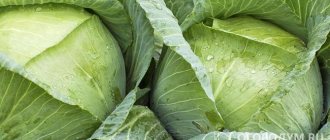Origin of cabbage Rinda F1
Rinda cabbage is very popular in many countries. One of the reasons for her international fame is her origins. The variety was developed and promoted by one of the largest growers - Seminis Vegetable Seeds. The company was founded in 1994. The share of its products on the world market is 20%. There are more than 3,500 types of seeds available in retail.
In 2005, Seminis became part of an even larger structure - Monsanto Company. This company is known as the manufacturer of the world-wide herbicide Roundup. The main office is located in Missouri (USA).
Rinda F1 (Rinda) is a hybrid of medium-ripening white cabbage. The variety is included in the State Register of the Russian Federation. This means that the crop has passed a quality check by a local certification body, and the foreign manufacturer has received a Russian certificate. Rinda is certified for the Central and Volga-Vyatka regions. Perhaps in other regions of Russia this variety will not be able to show all its positive qualities.
Characteristics of the variety
Rinda - mid-season cabbage. It takes 100–110 days from germination to technical ripeness, and 70–80 days from planting in the ground. Productivity largely depends on weather conditions and quality of care. One head of cabbage can grow weighing both 3 kg and 8 kg. Russian gardeners managed to get 12 kg. Typical weight for Rinda is 4–6 kg.
Botanical features and purpose
Rinda's leaves are dark green with clearly visible light veins. The head of cabbage is dense, has a spherical shape, and is resistant to cracking. The stalk inside is short.
This variety is recommended to be used fresh and for pickling. When cut, cabbage is yellow-white. Rinda has an excellent taste, without bitterness.
Table: pros and cons of the Rinda variety
| Advantages | Flaws |
| High yield. | In the shade it may not set heads. |
| Resistance to cracking both in the garden and during transportation. | Like all cabbages, it is affected by slugs, cabbage bugs, and cruciferous flea beetles. |
| Great taste, no bitterness. | Due to the popularity of the variety, many fakes go on sale. |
| Short stalk. | |
| Undemanding in care. | |
| Resistance to common cabbage diseases. | |
| Universal purpose. |
Reviews about the hybrid
Experienced gardeners speak positively about the Rinda cabbage variety, noting its high taste and unpretentiousness.
Lyubov Mikhailovna, Moscow region: “I’ve been growing cabbage for a long time, but I planted Rinda for the first time this year. I was pleased with this variety. The seedlings are well received. The seedlings are strong and quickly gain strength. The heads of cabbage are very dense and sweet. We ate both fresh and fermented - delicious. I’m satisfied, I’ll plant again.”
Svetlana, Kazan: “We have a proven variety; all our neighbors grow it. Problem-free cabbage, does not get sick, the plants are strong and strong. And fast, I already start filming in August. The heads are not the largest, but firm and sweet, without bitterness.”
Planting and care
Rinda cabbage is planted in open ground as seedlings or seeds are sown directly into the ground. Each of these methods has its own characteristics.
Selecting a site for planting
For Rinda cabbage, choose a plot that is open to the sun's rays from morning to evening. Shadows from neighboring trees, bushes, fences or tall crops should not violate this rule. In the shade, Rinda may not plant a head of cabbage, but only present a lush rosette of leaves.
The best precursors for cabbage: garlic, onions, beans, peas, cucumbers, zucchini, carrots and potatoes. You cannot plant Rinda after radishes, turnips, turnips, rapeseed, mustard, and watercress. Like cabbage, these plants belong to the cruciferous family. They have already removed the necessary nutrients from the soil and endowed the area with pests and diseases characteristic of this particular family. Although cabbage itself can be grown in one place for 2 years, it is not recommended to return it back earlier than after 4 years.
Another condition is appropriate soil acidity. Cabbage grows well at a pH of 6.5–7.5, that is, in neutral and slightly acidic soils. You cannot get a good harvest on acidic soil. Acidity is determined using litmus paper (sold in chemical stores). You can use table vinegar (9%) for this purpose. Place a handful of earth on a board or glass, pour a little vinegar on it. If there is a violent reaction (with hissing and numerous bubbles), then the earth is alkaline, moderate foaming is neutral, and there is no reaction - acidic. The soil for the sample is taken from a depth of 35 cm, approximately at this level the cabbage roots are located.
Video: determining soil acidity in different areas
Soil preparation
Acidic soil can be corrected by adding fluffed lime, crushed chalk or dolomite flour in the fall (1-2 cups per 1 m²). On acidic soils, the risk of clubroot infection increases and the effectiveness of fertilizers decreases. Rinda will not receive enough nutrients and will develop worse.
In the fall it is necessary to apply fertilizers, the norm per 1 m²:
- 30–35 g of double superphosphate and 40–50 g of potassium sulfate;
- 1.5 buckets of humus and 1–2 cups of wood ash.
In the spring, add up to 45 g per 1 m² of urea or 1.5 buckets of humus, if you did not dig up the ground with it in the fall. The norms are given for the poorest soils. If fertility is maintained every year, then the dose of mineral fertilizers should be halved. Cabbage does not absorb them well and tends to accumulate nitrates. If organic matter is used, it is better to avoid mineral fertilizers.
The site has been dug up since the fall, without breaking up the lumps. Early in spring the ground is leveled with a rake.
Video: how to prepare a bed for cabbage in the spring
Sowing seeds
There are three ways to obtain planting material for Rinda cabbage:
- grow from seeds at home, on the windowsill;
- sow the seeds immediately in open ground:
- buy ready-made seedlings.
How to grow Rinda seedlings on a windowsill
- Rinda ripens in 100–110 days after germination.
- Cabbage seeds germinate quickly—in 3–7 days.
- 35-day-old seedlings are planted in the ground.
- Favorable temperature is 15–17 °C, withstands frosts down to -5 °C.
Knowing this, you can calculate the timing of sowing and planting yourself, since they depend on the climatic characteristics of each specific region. Rinda is mid-season; its seedlings are usually planted from mid to late May. Seeds need to be sown 40–45 days before, which means in early April.
For sowing, in the fall, a soil mixture is prepared from 1 part soil, 1 part humus and wood ash (1 tablespoon for each kilogram of soil mixture). You can buy ready-made soil for seedlings, universal or specifically for cabbage. They are sold under the brands: Bio Master, Our Dacha, Success, Garant, etc.
Modern manufacturers produce a wide variety of high-quality soil mixtures for seedlings.
Before you start sowing, carefully read the instructions on the seed packet. It happens that the seeds have already been processed, then you need to follow the manufacturer's instructions. If there is no mark and it is not clear that the seeds have been somehow processed, then experienced gardeners recommend doing the following:
- Dissolve honey in water (preferably melted water): 1 tbsp. l. for 500 ml;
- seeds are placed in the solution for 30 minutes;
- the soaked seeds are placed on a sieve and dried;
- powdered with biological bactericides to prevent diseases (Gamair, Alirin).
Now the seeds can be sown. The optimal temperature before germination is +20 °C. As soon as the seedlings sprout, they should be transferred to the brightest and coolest window (+10 °C). Otherwise, the seedlings will stretch out. The soil should always be moist, but in a city apartment it is poorly ventilated. There is a high risk of blackleg disease. Therefore, the row spaces are dusted with ash, and 2 weeks after germination, they are watered with a solution of the fungicide Glyokladin. The drug suppresses the development of fungal diseases on all crops grown indoors.
If the soil is initially filled with organic matter and microelements, then there is no need to feed the seedlings. If such soil is not found, then you can feed it with complex fertilizers for seedlings, for example, RosPochva. Instructions on how and when to feed are included with each fertilizer.
The seedlings are ready for planting in a permanent place
Growing Rinda by sowing in open ground
If there is no super-sunny window, a heated greenhouse, or the desire to illuminate the cabbage with a special lamp, then the seedlings will definitely stretch out. In addition, when transplanted to the site, she gets very sick. Some plants die without taking root. Therefore, there is now a tendency to sow cabbage seeds directly into open ground. There are positive reviews about this experience, and specifically about the Rinda variety.
When sown in May, Rinda heads will reach technical ripeness at the end of August-September.
Stages of cultivation by sowing in open ground:
- Planting scheme for Rinda: 70 x 45 cm. According to this plan, you need to make holes in the area prepared for cabbage.
- Fill the holes with water so that the soil is moist to a depth of 20 cm.
- Plant 3-4 seeds in each hole, cover the nest with the top of a plastic bottle with a stopper (cut off the bottom). Such a mini-greenhouse can also be ventilated.
- After germination, you need to leave one of the strongest plants in each hole. The rest are pinched rather than pulled out, so as not to damage the root of the remaining sprout.
- The plant can be kept in a plastic bottle until the leaves begin to touch the walls.
In spring, any young cultivated plant is a treat for insects. As soon as you remove the cover, cruciferous flea beetles can attack the cabbage sprouts and eat them literally within a day. To make cabbage unpalatable to pests, you need to water it with plain water from a watering can and dust the wet leaves with ash, tobacco or shag. After watering or rain, the procedure is repeated. Otherwise, caring for cabbage planted by direct seeding in the ground is no different from caring for cabbage grown from seedlings.
Video: how to grow cabbage in a plastic bottle (seedless method)
Boarding pattern and time
Cabbage seedlings aged 30–35 days, purchased or grown on a windowsill, are transferred to a permanent plot. It is advisable to choose cloudy, rainy weather, then the plants will be less damaged by the sun. On hot days, Rinda is planted in the evening, and during the day she will have to be shaded and given a “shower” from a watering can 2-3 times a day. Don't rush to plant all the cabbage at once. If some plants do not take root and die, the seedlings remaining in the box can be planted in their place.
Caring for cabbage in open ground
Any cabbage loves regular watering and feeding. The Rinda variety is no exception.
Watering
For the first two weeks, plants are watered once every 3-4 days. Water consumption for each root is 1–1.5 liters. After 10–14 days, water the entire soil in the cabbage bed, and not just around the plant. 8–10 liters of water are spent per 1 m². During the period of setting heads of cabbage, the norm increases to 15–20 liters per 1 m².
It is necessary to water every 3-4 days, and in the heat and during the period of growth of heads of cabbage - every other day. This regime is maintained throughout the entire cultivation and watering is stopped 2 weeks before the onset of technical ripeness. For Rinda, this occurs approximately 100 days after germination and 70 days after planting the seedlings. If the seedlings were planted in mid-May, then they stop watering at the end of July.
Don't rely on rain. Showers are rare; short-term, light precipitation occurs more often. Take a handful of soil from a depth of 30–40 cm. If it does not stick together into a lump or crumbles, then you need to water it, despite the rain.
Table: timing and norms for watering cabbage
| First 2 weeks in open ground | Every 3–4 days (every other day in hot weather) 1–1.5 liters per plant |
| 10–14 days after disembarkation | Every 3–4 days (every other day in hot weather) 8–10 liters per 1 m² |
| During the period of growth of heads of cabbage | Every other day, 15–20 liters per 1 m² |
Loosening and hilling
You need to loosen the soil in the cabbage bed after each watering or rain. Otherwise, a crust will form on the soil. Oxygen does not reach the roots, which can lead to weakening of the plant and various diseases.
Ordinary cabbages form a high stem, so they are hilled 2-3 times during the summer, but they still sometimes fall to one side under the weight of the head of cabbage. Rinda is not an ordinary cabbage, but a hybrid with a short stem. For this variety, one hilling is sufficient during the period when a lush rosette of 5–6 leaves has developed.
Video: hilling hybrid cabbage while simultaneously preventing cabbage fly damage
Fertilizers for cabbage: timing and application rates (table)
| 15–20 days after planting or sowing in the ground |
Consumption: 0.5 l of one of the solutions for each plant. |
| 2 weeks after the first feeding |
Consumption: 1 liter of one of the solutions for each plant. |
| 2 weeks after the second feeding |
Consumption: 6–8 l per 1 m². |
You can skip the first fertilizing if, when planting, complex fertilizers for cabbage were poured into each hole. You need to feed on damp soil. It is better not to add fertilizers than to overdo it.
Brussels
Types of Brussels cabbage (photos with names can be seen in various sources) are distinguished by their original appearance. It is a thick stem to which tiny heads of cabbage are attached, ranging from 20 to 40 pieces. Brussels sprouts are valued by vegetable growers for their excellent taste and ability to easily tolerate moisture deficiency.
The most popular varieties are:
| Name of variety or hybrid | Description and characteristics | pros | Minuses |
| Hercules | A late-ripening variety that requires at least 140 days to ripen. Feels great in frosts down to -10° C, but does not tolerate heat. The heads of cabbage are loose, medium in size, slightly elongated | · high yield from 1 bush: on average – up to 30 fruits; Possibility of use in preparing various dishes | Requirement for care |
| Bunch of grapes | Late-ripening cabbage (vegetative period - 160 days), the spherical heads of which are in the amount of 35-40 pieces. have a purple color | · delicate taste with nutty notes; · unpretentiousness; · transportability; · attractive presentation | Sometimes there is a bad connection of swings |
| Sapphire | Drought-resistant, beautiful variety, distinguished by intense color and neat arrangement of absolutely identical heads of cabbage in the amount of 30-35 copies. The plant takes 120 days to ripen; harvesting occurs when the fruit reaches a diameter of 30-40 mm | Excellent taste | The plant does not develop well in the shade |
Diseases and pests of Rinda cabbage
Although the variety is disease-resistant, improper care often leads to trouble. Rinda may develop poorly and become ill with widespread cabbage diseases if:
- do not observe crop rotation;
- do not remove roots and leaves from old cabbage in the fall, the disease will certainly settle on such remains, and then spread throughout the entire area on the soles of shoes;
- do not weed, weeds attract pests and create a favorable microclimate for fungi and viruses;
- do not break the crust on the soil;
- do not comply with the norms and irrigation regime.
Cabbage diseases and treatment methods - table
| Disease | Signs | Treatment | Prevention methods |
| Kila | Clubroot develops on the roots in the form of swellings of various shapes. These growths grow, then collapse and infect the ground. Seedlings infected with clubroot die. If an adult plant gets sick, its leaves turn yellow, the head does not set or becomes loose. |
|
|
| Cabbage mosaic | Holes, brown and black spots appear on cabbage leaves and heads of cabbage. | Mosaic is difficult to treat. It is better to remove the diseased plant from the garden and burn it to protect the rest. | As a preventive measure it is recommended:
|
| Vascular bacteriosis | The leaves turn yellow, the veins turn black, and the head of cabbage, before it has time to grow, begins to rot. The disease continues to develop during storage. The virus is transmitted through plant debris in the soil, through seeds, and carried by insects. | At the first signs of illness, spray with Planriz solution, repeat after 20 days. |
|
The most common diseases of cabbage in the photo
Cabbage roots affected by clubroot. In the initial stage, the growths are not so obvious, they may be no larger than a bead
Covering leaves are covered with holes, black and brown spots
The leaves turn yellow and the vessels (veins) turn black. This is where the name of the disease comes from
Cabbage pests and ways to combat them - table
| Pest name | Description | Ways to fight |
| Cruciferous flea beetles | Small leaf beetles (2–4 mm in length) have an oval, convex shape. Color: black, blue, metallic green, with orange stripes. Individuals can jump like fleas and fly well. In a short period of time, pests can destroy young plantings and severely damage older ones. | Fleas do not like strong odors, so they are easy to fight without any chemicals. It is enough to dust wet cabbage leaves with a mixture of ash and tobacco (1/1) or pure tobacco or shag. You can water the cabbage by adding fir oil to the water (15 drops per 10 l). |
| White butterfly and cabbage scoop | These are different insects, but they cause the same harm: they lay eggs on the underside of cabbage leaves. Caterpillars emerge from them. At first they are inactive and stick together, then they spread and eat leaf by leaf, leaving only thick veins. | If you do not want to collect caterpillars by hand, cabbage is sprayed with the following preparations: Fury, Kemifos, Iskra-M. If you plant marigolds around the perimeter of the cabbage bed, they will scare away butterflies with their smell. |
| Cabbage fly | The pest looks like an ordinary fly. Flight begins during the flowering period of the birch, and when the cherry blossoms, the cabbage fly lays eggs in cracks in the soil near the cabbage stem. The emerging larvae gnaw through the stems, live and feed in them. The plant weakens and withers in hot weather. | During the summer, you need to sprinkle the cabbage stems with a mixture of ash and tobacco (1/1). Chemical method: 20 g of karbofos emulsion (30%) is diluted in 10 liters of water. Pour 0.5 liters of solution into each well. You can simply scoop the eggs off the cabbage. They are white and clearly visible. The newly born larvae will have nothing to eat and will die from exhaustion. |
| Slugs | These gastropods are very gluttonous; they love cabbage for its juiciness and frequent watering. During the day they hide in heads of cabbage or in any dark, warm and humid place. They are nocturnal. At the age of two months, eggs are laid under lumps of earth. | An insurmountable obstacle for slugs will be a groove dug around the entire perimeter of the bed with tobacco, ground hot pepper or ash at the bottom. There are also chemicals: Thunderstorm and Meta. |
Photo gallery: cabbage pests
Cabbage leaves infected with cruciferous flea beetles
Cruciferous flea beetle is a leaf beetle of black, metallic green or blue color, 2–4 mm long
Young caterpillars of the white butterfly are at first motionless, stick together, and then spread apart. They feed on the tender pulp on the underside of the leaf.
Owl caterpillar and butterfly. 2–3 generations grow per season
The pest looks like an ordinary fly
Slugs feed on succulent cabbage leaves and often crawl inside the head of cabbage.
Seed preparation
If the seeds are not brightly colored and have not been processed by the manufacturer, they will have to be disinfected yourself, regardless of the method of growing cabbage. To do this you need to do the following:
- Select viable specimens. To do this, pour the seeds with a salt solution (40 g per 10 liters of water). Those that float to the surface should be discarded as they are either empty or damaged.
- Calibrate the seeds remaining at the bottom, that is, select among them medium and large specimens measuring 1.5-2.5 m.
- Soak the selected material in hot water (50°C) for 20 minutes and in cold water for 5 minutes. Next, place the seeds on a towel and dry. To speed up germination, they can be soaked in water at room temperature for 12 hours, but it will have to be changed every 4 hours. To harden, soaked seeds should be kept cool for a day (+1-2°C), for example, on the bottom shelf in the refrigerator. After this, they need to be dried to eliminate stickiness.
To increase germination, seeds can be additionally treated in a solution of humates or EM preparations.
Harvest and storage
Rindu is removed from the garden at the end of September. You need to choose a sunny, dry and cold day. The air temperature is 3–4 °C above zero. Cabbage harvested in warm weather will not be stored for long. The cut is made at ground level, it should be smooth and horizontal. Leave 3-4 covering leaves. The roots and leaves remaining after harvesting can be composted only if the cabbage has not been sick in any way.
Cut heads of cabbage should not be kept in light or heat. Cabbage without roots quickly withers and loses its elasticity. For fresh storage, choose the densest heads of cabbage without damage and not frostbitten. The cabbage is laid out on racks in a well-ventilated cellar so that the heads of cabbage do not touch each other. Can be hung by stalks. Mid-season varieties do not last long - 1–3 months.
Rinda is great when fermented. Fresh cabbage leaves are thin and elastic (non-fragile), so the variety is ideal for making cabbage rolls.











